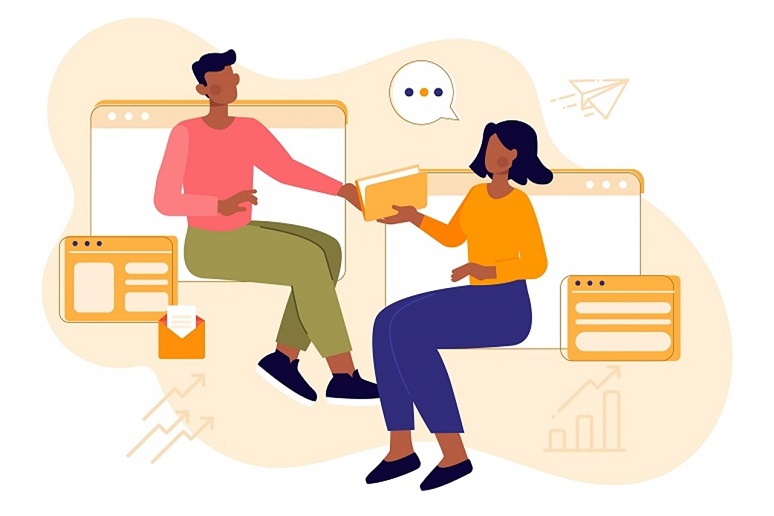Effective communication. Yawn. Effec – yawn. Sorry – “effective communication” is a phrase that almost guarantees your mind will wander because it’s something you hear at the beginning of collegiate lectures or at sales training sessions led by someone who will never be successful in sales. So, let’s ditch the yawn-inducing phrase and focus on what “effective communication” is meant to describe instead. A clever colleague likes to say, “Make Good Talk."
Making good talk requires consideration and preparation – more now than ever before. In the last two-plus years, we’ve spent a great deal of time working from behind our screens, limiting our face-to-face interactions for the sake of our health and others. Consequently, we’ve all changed our social behaviors thanks to technology. Ever seen people text each other at the dinner table?
In our screen-based lives, we bang out emails and texts and interact on social media, paying very little attention to how we are being perceived by our audience. Or worse, reading into other people’s responses as to why or how they’ve misunderstood us. After all, we know exactly what we mean to communicate, so why isn’t the intended audience reacting as we hoped? Why don’t they “get it?”
So, it might be time for us all to reexamine our “good talk” techniques, lest they rust.
As we move more into the hybrid workplace and find a need to switch between collaborative workspaces and in-person meetings, honing our live communication skills can help us convey our thoughts and ideas more effectively. Let’s look at three strategies anyone can adopt and practice in a number of situations: conversations with coworkers, in formal meetings, with our managers or subordinates, when giving or soliciting feedback, when engaging a group and when interacting with someone they’ve only “met” on screen.
Preparing for the Discussion-The Approach Shot
In golf, the approach shot sets up success for the rest of the play. A short chip onto the green can land you next to the hole, or if done incorrectly, can leave you on the other side of the green, flailing away while the rest of your party has putted out.
The first approach to your target audience sets the tone for how they will (or not) receive your message. Having a mindset of empathy can help here: what is your audience currently doing? Are they distracted or engaged expectantly? Have you formulated what you would like to say? If presenting a problem to be solved, what are the potential solutions you’ll be offering? Are you tense or relaxed, and does that state show on your face? How might you receive the message you’re about to deliver if you were the audience? Putting time and care into your approach shot can help you carry your message through on a smooth putt.
Bring Your Authentic Self to the Interaction
Have you ever been approached for a conversation with someone, and there was just something about their delivery that tempted you to turn off? Perhaps you felt a bit guarded or suspicious of their motives? If so, it’s likely that you perceived some lack of authenticity or sincerity about their motives.
Conversely, I’m sure you can remember times when you’re engaged in a discussion with someone and find yourself in such agreement that you nearly finish their sentences for them. If you stop to examine what’s causing you to react in such a positive way, it’s likely because you’ve assessed that person as authentic and therefore, trustworthy.
In any effective communication, it’s essential to establish trust for both parties to achieve their desired outcomes, and it can be difficult to trust someone if you feel they’re not authentic.
In almost all sales training programs, the salesperson is taught to “establish rapport” in order to get what they (the salesperson) want. It’s as if none of us has ever seen that gambit before, but they persist in mimicking body language, conversational tempo and tone, and a host of other tricks to fool the intended target into feeling secure, into sensing “rapport.”
Merriam-Webster defines rapport as:
a friendly, harmonious relationship
especially: a relationship characterized by agreement, mutual understanding, or empathy that makes communication possible or easy
So, it seems quite unlikely we’ll develop a warm and trusting relationship with someone by mirroring their body language.
Instead of striving for that mirror-image illusion of rapport, I have another suggestion: Establish a connection with your target audience. We have all been disconnected from one another for over two years, in varying degrees, and by bringing humanity back to our conversations, through being our authentic selves, we can foster mutual empathy and therefore, a connection. Speak from the heart. Make gentle eye contact. Relax into the conversation and try to avoid interrupting.
People feel connected when they feel valued, and they feel valued when they feel heard. Try to avoid the “fake nice” and find something in that person to appreciate. You’ll know when you’ve made that important connection, and so will they. And they will trust you.
Ensure the Message Sent Equals the Message Received
“Communication is not about speaking what we think. Communication is about ensuring others hear what we mean.” – Simon Sinek.
Now that we’ve perfected our approach shot, and summoned the courage to be our authentic selves, what’s next? How do we meet minds with our target audience? By making sure that message sent equals the message received.
In almost every communication engagement, the audience members will have their own agendas and objectives, and if we’ve nailed our approach shot, we’ve prepared the audience members to receive our message as we intend it to be. If we communicate with authenticity, we reduce the chance that the recipient of our message is guarded. Our audience wants to get something out of this engagement as well, so if we keep that fact in mind, and help them get something for themselves out of the conversation, we go a long way toward achieving mutually satisfying outcomes.
The equal sign in our communication coaching reflects that each party in a discussion is at the same level. Being aware of the other’s filters and experiences will help us package our information in a way that the recipient understands exactly what we are trying to convey. If we overuse technical jargon or acronyms, and our recipient doesn’t understand those terms, we will be in over their head. If we “dumb down” our terminology too much or oversimplify, our target might feel as if their intelligence has been underestimated. Speaking with them at their level will assure that our message has a good chance of being received.
But that’s not all. As we’re speaking to someone, it can be helpful to clarify along the way. Seeing your audience nodding their heads in agreement doesn’t necessarily mean they fully understand: it could mean they’re too embarrassed to admit that they don’t. I’ve found that a simple check-in as you’re going through your points can help. “Does this resonate with you?” can be a good, non-threatening validation that you’re getting through.
Validation in the other direction is helpful as well. As someone is speaking to us, and once they believe they’ve made their point, it can be refreshingly validating to the speaker to say, “I think what I’m hearing you say is ______________. Is that right?” It will make them feel heard, and if they wanted to convey something different, it gives them a graceful way to confirm or restate.
As we’re going through this phase of the communication, it’s helpful to remember a few tips:
- Listen for comprehension and try to avoid formulating your response while your conversational partners are still speaking. Avoid jumping to conclusions.
- Clarify what you think you heard.
- Ask thoughtful questions.
- Try to help your conversational partners get what they might want out of the discussion.
By practicing and employing your approach shot, your authentic connections, and your confirmation that you and your conversational partners are sending and receiving the same message - by “making good talk” - you can go a long way in building trust with your audience, and confidence in yourself, in all kinds of situations. And trust is where the magic happens!
Linda is writing on behalf of the SCTC, a premier professional organization for independent consultants. SCTC consultant members are leaders in the industry, able to provide best of breed professional services in a wide array of technologies. Every consultant member commits annually to a strict Code of Ethics, ensuring they work for the client benefit only and do not receive financial compensation from vendors and service providers.





